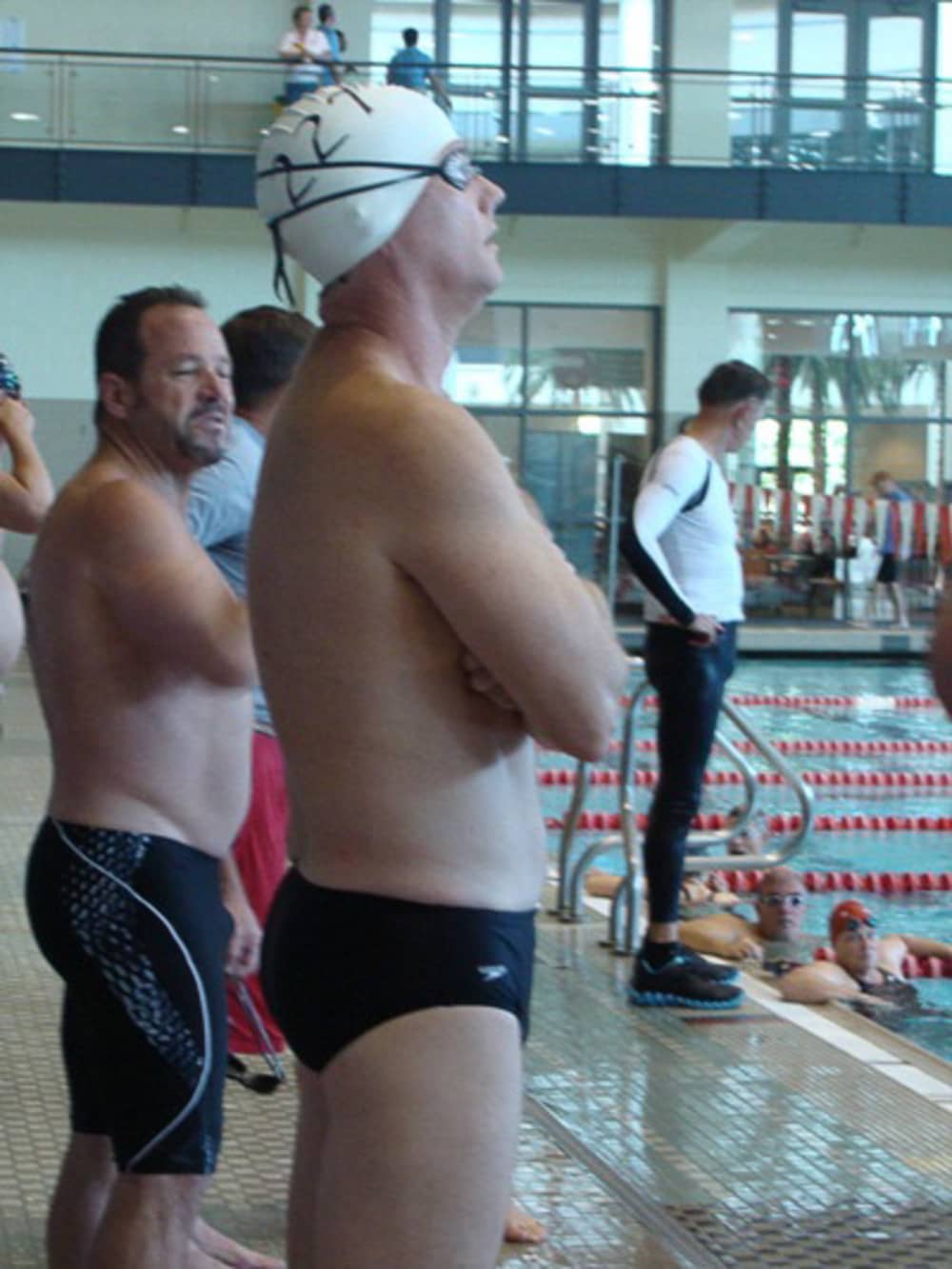Senior moments
My poolside search for a Silver Hero at the Senior Games: From a blind racer toa 61-year-old hunk
 How old do you think this man is?Photo by Cherri Carbonara
How old do you think this man is?Photo by Cherri Carbonara Bruce Rollins, left, and guess-who's-61, Steve HeckPhoto by Cherri Carbonara
Bruce Rollins, left, and guess-who's-61, Steve HeckPhoto by Cherri Carbonara Vivian, who is blind, and Turner StancilPhoto by Cherri Carbonara
Vivian, who is blind, and Turner StancilPhoto by Cherri Carbonara Swimmer Rhonda Radcliffe, who also competes in track and fieldPhoto by Cherri Carbonara
Swimmer Rhonda Radcliffe, who also competes in track and fieldPhoto by Cherri Carbonara ConcentratingPhoto by Cherri Carbonara
ConcentratingPhoto by Cherri Carbonara The winning spiritPhoto by Cherri Carbonara
The winning spiritPhoto by Cherri Carbonara Ready to startPhoto by Cherri Carbonara
Ready to startPhoto by Cherri Carbonara Athletes at poolsidePhoto by Cherri Carbonara
Athletes at poolsidePhoto by Cherri Carbonara The swimmers are off the blocks!Photo by Cherri Carbonara
The swimmers are off the blocks!Photo by Cherri Carbonara A backstroke competitorPhoto by Cherri Carbonara
A backstroke competitorPhoto by Cherri Carbonara
I have become fascinated by a phenomenon I call the Silver Hero — someone who doesn’t allow age to define him or her, but uses it as a lever to springboard in a whole new direction or push personal achievement to new levels. “Silver” refers to the inevitable gray hair of aging and “Hero” describes the bold act of defying conventional wisdom.
I believe, if there’s a Silver Hero lurking in us, it shows up sometime after 50 — when the world begins to press down harder on what you can and can’t do and, in some respects, your body becomes more vocal about what it is willing and not willing to do.
While poolside Sunday at the Senior Games swimming competition, I ran into several folks whom I would nominate for Silver Hero.
Vivian Stancil: Being blind is not an obstacle in the pool
Vivian Stancil, 54, wasn’t the fastest woman in the 100-yard freestyle competition, but she certainly got the loudest applause. Although a healthy distance behind the nearest competitor, the collective cheering got louder and louder the closer she got to the finish.
It was undoubtedly the biggest fanfare of the morning — cheers for Stancil and for the indomitable human spirit. I may have forgotten to mention that Stancil is totally blind.
Looking around at these older athletes, I noticed far fewer examples of what I call “Buddha belly” among the men and so many well-toned arms and shapely, firm legs among the women.
As the Californian tells it, she took up swimming at age 50 because she weighed 320 pounds. “My doctor said that if I didn’t lose weight, I wouldn’t make it to 60,” she said with a grin.
Now an energetic 64, Stancil loves swimming competitively. By her side is Turner, her husband of 31 years, who beams with obvious pride as his wife talks about her sport.
“Turner and I have had a chance to travel all over because of this,” she said. “It’s been just great.”
Rhonda Radcliffe: A bionic woman in 13 events
As the next heat gets started, I notice a petite woman with long, wavy silver hair and twinkling blue eyes. She had a friendly smile and a great figure, so I decided to ask her how the competition was going.
Turns out Rhonda Radcliffe, 56, from Tennessee had already completed earlier in the week in seven Senior Games track and field events — high jump, javelin, pole vault, long jump, triple jump, plus 100 meter and 200 meter runs. Now she was finishing up six swim events. Clearly Radcliffe’s been eating her Wheaties.
She said she swims competitively because it’s a great way to stay in shape. On average, she trains two to three times a week and also practices her track and field sports, too. She has the 2004 U.S. Olympic gold medalist, Tim Mack, as her pole vaulting coach so she’s serious about improving her performance even though she’s a newcomer to the sport. At the same time, Radcliffe believes swimming is the sport with the most longevity, simply because it’s easier on the joints.
As proof, Radcliffe points to her friend, fellow Tennessean and senior games competitor 91-year-old Hollyce Kirkland, who is competing in six swimming events over the next two days.
“That just shows you that you can do this a long time,” Radcliffe said. Then she laughed and added, “I figure if I outlive everyone, that’s one way to get a gold medal."
A mother of three children and grandmother of two, Radcliffe says she likes to stay active and try new things. Her kids have taken her skydiving and motorcycle riding and they all serve on ski patrol together. Her energy and enthusiasm tell you she isn’t going to stop being active or competing — she’s having a great time.
Steve Heck & Bruce Rollins: Hunky & fit at age 61
Looking around at these older athletes, I noticed far fewer examples of what I call “Buddha belly” among the men and so many well-toned arms and shapely, firm legs among the women. While they weren’t all the perfect bodies of Olympic competitors, everyone for the most part had a decidedly sleeker, fitter look about them than your average crowd of 50-plus adults.
Steve Heck from Katy was one such specimen of fitness that caught my eye as he passed by. When I learned the retired chemical engineer was 61, I just had to snap a photo for those of you who might need a bit of an incentive to abandon your mid-life couch potato ways.
I asked Heck if he would share a bit about his training. “Sure,” he said. “But first I have to go win this 100-yard freestyle race. I am up in about three minutes.”
Now that’s confidence, I thought, as he strode off.
As I watched him dive from the blocks, sure enough, exactly 55.17 seconds later he had handily beat the other seven competitors who hailed from Florida, Washington, Texas and California.
Afterward I caught up with him and his training partner, Bruce Rollins, 61, from Houston. The two men swim at a local aquatics mecca called Dad’s Club located on Voss Road. According to Heck, Texas is a hotbed of U.S. Masters Swimming, which he joined at age 41. He and Rollins train at least two to three times a week at the Dad’s Club pool.
Why swim competitively for 20 years? “I do it to stay healthy, to feel fit. It keeps my heart and lungs in good condition and I feel good — that’s what it’s all about,” Heck said. He pointed out that heart disease has affected others in his family. His mother, father and younger brother have all had quadruple bypass surgery. So he has an added incentive.
The affable Rollins is both his friend and his biggest competitor, and that’s why Heck predicted he would win his meet. “Bruce had just finished swimming in the 200-yard breaststroke, so I knew he was a little tired,” Heck said. Both men chuckled at that.
Bruce talked about how he and Heck could train together, race hard against each other and remain really good friends. “We bring out the best in each other when we compete,” he said.
Rollins also shared why he keeps on swimming. “For me, it’s so I can see my grandchildren,” he said. The retired Proctor & Gamble executive explained that his daughters are 26 and 24 years old, so he figures those grandchildren might be a few years into the future and he wants to be in great shape to enjoy it.
Rollins adds that the competitive aspect of swimming, like in the Senior Games, is important. “The competition keeps us all training,” he said. “We all like to win, but the real goal is to beat your own best time. If you beat your time — then you win. It means you're maintaining your health, you’re staying in shape and you’re getting better.”
Obviously the competitive spirit is infectious among the Rollins family. Bruce had a cheering section that included his 87-year-old mom, his 58-year-old wife (she started started swimming competitively two years ago), his 26-year-old daughter and his 60-year-old sister, who is also a Senior Games swimming competitor.
“When you peel the onion on the Senior Games, we’re a community that supports each other,” Bruce said. “You compete with people from around the nation and you become friends with those same people.”
I imagine keeping up with those friends helps keep you young too.
When not watching hot senior swimmers while on assignment for CultureMap, Cherri Carbonara is founder and principal of The Carbonara Group.
